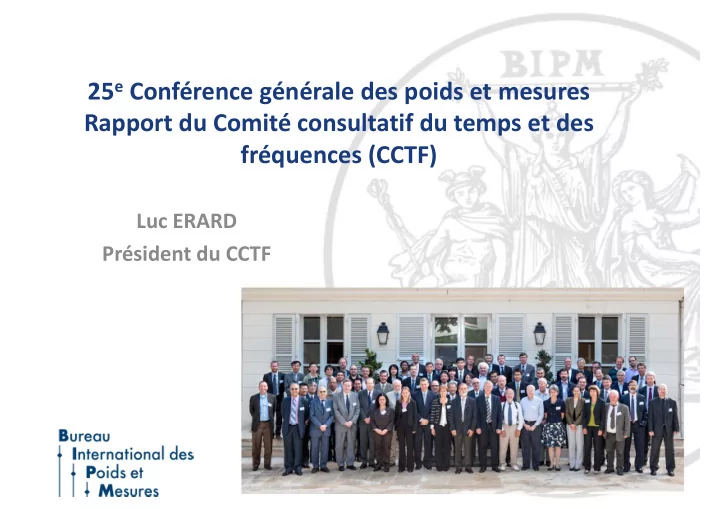

25 e Conférence générale des poids et mesures Rapport du Comité consultatif du temps et des fréquences (CCTF) Luc ERARD Président du CCTF
Metrological areas/Achievements: Time scales BIPM NMIs, DIs and others – UTC (CCTF ‐ K001.UTC) monthly, post ‐ – Real ‐ time local realizations processed UTC(k) – UTCr (rapid solution) weekly, post ‐ – Local atomic time scales TA(k) processed – Primary/secondary frequency – TT(BIPMyy) yearly (post ‐ processed) standards – Calibration of receivers – Time/frequency transfer (i.e. (BIPM/RMOs) optical fibres) Unique Key comparison CCTF ‐ K001.UTC BIPM Circular T ♦ Ongoing, monthly, 74 participants ♦ Two comparisons in one: ‒ local time scales: traceability of UTC (k) to the SI ‒ realizations of the second: comparison of the primary and secondary frequency standards for confirmation of the quality of the local realization of the SI second ♦ Information of the access to UTC via GNSS > broad dissemination of UTC
Metrological areas/Achievements: The SI second ♦ Primary realization: caesium ‒ 16 Cs frequency standards operated in NMIs have contributed since 2011: 2 thermal beams, 14 fountains ‒ Accuracy 2 ‐ 3 parts in 10 16 (fountain), 10 ‐ 20 parts in 10 15 (thermal beam) ‒ One under consideration (October 2014) Secondary representations of the second – Recommended list of frequencies/wavelengths (CI ‐ 2013) – Microwave (Rb fountain, accuracy 2 ‐ 3 parts in 10 16 ) – Optical transitions (accuracy parts in 10 18 ), ratios of optical frequencies Trapped single ions and neutral atoms trapped in optical lattices (Hg, Sr , Yb , Al, Ca, In, Mg,..)
Major challenges Redefinition of the SI second – Developing optical standards with 10 ‐ 18 frequency accuracy at NMIs; – Comparing optical standards with the highest accuracy over long distances (optical fibres, TWSTFT, microwave and optical links, VLBI,..); – Operating optical standards over long intervals for reporting to the BIPM. BIPM and contributing laboratories – Improving UTC stability, accuracy and dissemination; providing prediction on a shorter delay; – Algorithms.
Stakeholders/Inter ‐ disciplinary issues Organization/Activity Stakeholder Inter ‐ disciplinary issues CCL Length metrology Wavelength Time scales NMIs, observatories, Traceability to UTC universities, space agencies Telecommunications ITU Dissemination of UTC Radiocommunications Synchronization to UT1 Global Navigation Satellite GPS, GLONASS, Galileo, Dissemination of UTC Systems (GNSS) BeiDou, … GNSS System Times Time transfer for UTC Earth and space sciences IAU, IUGG/IAG, URSI, IERS, Space ‐ time references IGS GNSS civil applications Conventions ICG, CGSIC Time transfer for UTC
Future strategy Frequency standards – Assist to the decision of a new definition of the second by Determining the best representation of the SI second and its uncertainty: which physical standard(s) Developing portable highly accurate primary standards for confirming the innovative long ‐ distance comparison methods Time scales – Stronger coordination work on upcoming time scales developed for different applications (GNSS, dynamical ‐ pulsar time scale, etc.) – Adapting algorithms following clock and frequency standard improvement – Providing the reference UTC on a shortest delay for supporting new applications Time and frequency transfer – Implementing ground ‐ based techniques (optical fibres) targeting 10 ‐ 18 frequency transfer accuracy – Extending to novel space ‐ based techniques targeting 0.1 ns time transfer uncertainty and to allow 10 ‐ 18 frequency transfer accuracy over all distances
Recommend
More recommend